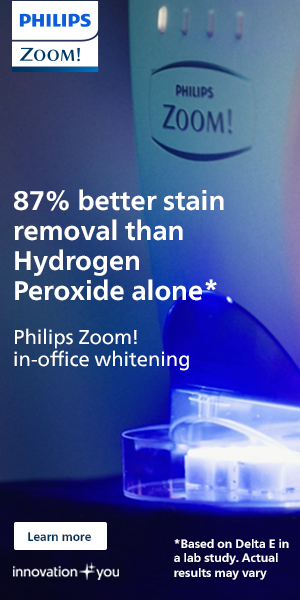Written by: Kiran Shankla, BDS, MSc, MFDS, RCS
INTRODUCTION
Dental hypoplasia affects 1 in 8 children in the UK.1 The exact cause is not fully understood, but it may result from disruptions in tooth development around birth or during the early years of life. Potential causes include severe childhood illnesses, high fevers, or a traumatic birth experience.
The front and/or back teeth may become discolored, appearing cream, yellow, or brown. These teeth may experience pain, sensitivity, and even break down. With softer enamel, they are more susceptible to decay. In some cases, it may be harder to numb the tooth using local anesthetic.
It is well documented that the presence of noticeable teeth discolorations can result in psychological and psychosocial effects.2 The emotional effect on a child resulting from delayed treatment can lead to a negative self-image and can have serious consequences on adolescents. As such, treating discoloration and disease may aid in the prevention of bullying and prevent mental health conditions such as depression and suicide.3 It is imperative to limit the amount of tooth tissue sacrificed at such a young age to allow long-term vitality and longevity of the teeth.4
The location and extent of tooth damage can vary from patient to patient. Previously, color abnormalities were corrected using direct or indirect restorative materials, which provided satisfactory aesthetic outcomes. However, these restorations often require frequent repairs and replacements, leading the tooth to enter a continuous restorative cycle.5
Enamel microabrasion has commonly been used to remove superficial stains or discoloration from the enamel of the teeth. It involves the application of a mild acidic substance, often combined with abrasive particles, to gently polish the tooth surface. While microabrasion can effectively improve the appearance of mildly discolored teeth, it has some downsides, including limited effectiveness, temporary results, and potential sensitivity.
Icon Resin Infiltration (DMG America) was introduced around 2009, and aimed at treating early stages of tooth decay, such as white spot lesions, without the need for drilling. The technique uses a low-viscosity resin to penetrate and fill demineralized areas, effectively improving the appearance and strength of the enamel.
The goal of this article is to present 2 case studies to demonstrate the use of Icon Resin Infiltration.
Case Report 1
A 10-year-old female was externally referred to me to see if I could help treat her discolorations (Figures 1 to 3). During our initial meeting, the patient was very shy, reserved, and lacked the confidence to speak without looking at the floor.



Her mother explained the patient had discolorations of her upper incisors since eruption. She had been victimized at school and suffered from weekly bullying for having “dirty teeth” and for “not brushing her teeth.” This led to the patient becoming very upset and not wanting to go to school. The mother had discussed treatment options with her own dentist, who said the patient would need to wait until she was 18 years of age for veneers; there were no other options available.
A detailed history and examination were taken from the patient’s mother to help establish a diagnosis for the discolorations. It is very important to ask specific questions to help diagnose and identify the best treatment options, as discolorations that have been present since birth are more difficult to treat than those that appear later in life.
It is also extremely important to understand the physical and mental effects associated with discolored teeth and the emotional impact on a child resulting from delayed treatment.
In this case, a diagnosis of localized fluorosis was made.
Treatment options for this case were discussed in detail with the patient and mother, which ranged from doing nothing to placing full-surface, composite veneers. The final treatment plan consisted of whitening with an Icon Resin Infiltration.
The treatment started with simple oral hygiene instructions followed by a visit to a hygienist. Once we were satisfied the patient could maintain good oral health, an intraoral iTero scan (Align Technology) was taken to construct upper and lower whitening trays (Figure 4). The lab was instructed to construct a vacuum-formed, custom-made, non-reservoir, close-fitting tray made from 0.35 mm soft acrylic.

At-home whitening was carried out for 3 weeks using 10% carbamide peroxide (Pola Night [SDI]). My choice of whitening for young patients is Pola Night (SDI), as it contains potassium nitrate, which can help minimize sensitivity during treatment (Figure 5).

Following bleaching, there is a reduction in bond strength due to residual oxygen from the bleaching agent interacting with the formation of resin tags in the etched enamel. A minimum of 2 weeks must be left between the final whitening appointment and any bonding procedure.6 After a 2-week break, the patient presented for her resin infiltration appointment. A latex-free rubber dam (Unodent) was placed. It is extremely important to place a rubber dam for Icon treatment as the Icon Etch (DMG America) used is 15% Hydrochloric acid and can cause soft-tissue necrosis if left in contact with the soft tissues for a prolonged period.
A step-by-step protocol was followed for the Icon treatment. Icon Etch was placed on each tooth for 2 minutes. The etch was then rinsed off, and Icon Dry (DMG America), which is 99% ethanol, was used to assess the appearance of the discolorations. Icon Dry is the most crucial stage during this process as it allows you to see if the discolorations have successfully been treated. When wetted with Icon Dry, the whitish-opaque coloration on the enamel should fade. If the discolorations are still present, another 2-minute cycle of Icon Etch is required. In this case, we did 3 rounds of Icon Etch and 1 round of selective etch on the stubborn areas of the teeth (Figure 6).

Icon infiltrate was placed on the teeth for 3 minutes. Excess infiltration was removed using high-volume suction and a gauze. Each tooth was light cured for 40 seconds (Figure 7). A second round of infiltrate was placed on each tooth and left for 1 minute before light curing for 40 seconds each (Figure 8).


The teeth were polished using 3M Sof-Lex discs (Solventum) and A.S.A.P. purple and orange spirals (Clinician’s Choice). A No. 12 scalpel was used to remove any excess infiltrate near the gingival margins (Figures 9 to 11). The patient was reviewed 1 year later and showed no new signs of discolorations (Figures 12 and 13).





Case Study 2
A 14-year-old male was referred to me by his orthodontist to see if I could help treat his discolorations (Figures 14 to 16). In our initial meeting, the patient was very reserved and used his hand to cover his teeth when talking.



The patient was medically fit and well, with fair oral hygiene, no dental caries, or tooth surface loss. The patient visited his general dentist every 6 months for routine care. He was in mid-orthodontic treatment wearing an upper removable appliance when he first presented to me.
A full dental examination was carried out, and a diagnosis of fluorosis was made. Treatment options were discussed. A minimally invasive treatment plan of whitening plus Icon Resin Infiltration was selected as the treatment of choice.


A digital scan was taken to construct whitening trays. We prescribed 10% carbamide peroxide (Pola Night) was supplied for a duration of 3 weeks (Figures 17 and 18). On review, there had been a significant reduction in the brown discoloration. However, small patches were still present. The patient was instructed to whiten for another 2 weeks placing the gel toward the incisal edge on his trays (Figures 19 and 20). In total, 5 weeks of whitening was required. Following a 2-week break, the patient returned for his Icon Resin Infiltration treatment. Three rounds of Icon Etch were required, followed by Icon infiltration (Figures 21 to 23). There was an immediate difference at the end of treatment (Figures 24 and 25). The patient was reviewed at 6 months and was very happy with the results (Figures 26 and 27).









SUMMARY
As professionals, we have a duty of care to provide the best possible treatment while protecting teeth from unnecessary harm. Even though this treatment plan was very simple and straightforward to carry out, it is not done by many dentists.
As a clinician, it is very gratifying to help young patients grow their confidence in smiling again using minimal techniques.
REFERENCES
1. British Society of Paediatric Dentistry. Molar Incisor Hypomineralisation (MIH): A BSPD position paper on the dental condition affecting 1m UK children. British Society of Paediatric Dentistry website. January 2020. https://www.bspd.co.uk/Portals/0/MIH%20statement%20final%20Jan%202020.pdf
2. Craig SA, Baker SR, Rodd HD. How do children view other children who have visible enamel defects? Int J Paediatr Dent. 2015;25(6):399-408. doi:10.1111/ipd.12146
3. Arseneault L, Bowes L, Shakoor S. Bullying victimization in youths and mental health problems: ‘much ado about nothing’? Psychol Med. 2010;40(5):717–29. doi:10.1017/S0033291709991383
4. Greenwall-Cohen J, Greenwall L, Haywood V, et al. Tooth whitening for the under-18-year-old patient. Br Dent J. 2018;225(1):19-26. doi:10.1038/sj.bdj.2018.527
5. Ashfaq NM, Grindrod M, Barry S. A discoloured anterior tooth: enamel microabrasion. Br Dent J. 2019 Apr;226(7):486–9. doi:10.1038/s41415-019-0152-7
6. Chng HK, Yap AU, Wattanapayungkul P, et al. Effect of traditional and alternative intracoronal bleaching agents on microhardness of human dentine. J Oral Rehabil. 2004;31(8):811–6. doi:10.1111/j.1365-2842.2004.01298.x
ABOUT THE AUTHOR
Dr. Shankla graduated in 2013 from the University of Birmingham, UK. After this she worked for 2 years in the NHS before working in Australia as a general dentist. In 2016, she returned to the UK and completed a Masters’ in Restorative Dentistry at the prestigious UCL Eastman Dental School. She currently works in private practice at Kendrick View Dental Practice, Berkshire, UK. Dr. Shankla has had numerous case studies published around the UK and is an international speaker on Icon Resin Infiltration. She is a key opinion leader for DMG and SDI and is always at the forefront of using the latest innovations and techniques for her patients. She has been awarded a merit for her services to the British Dental Association and won Best Young Dentist for the Southeast in 2022 and highly commended in 2023. Her areas of interest are restorative adhesive dentistry, Icon Resin Infiltration, and short-term orthodontics. You can follow Dr. Shankla on her dental Instagram handle @shanklasmiles.
Disclosure: Dr. Shankla is a key opinion leader for DMG and SDI. She is paid for lecturing and writing articles in the UK. She did not receive financial compensation for writing this article.




